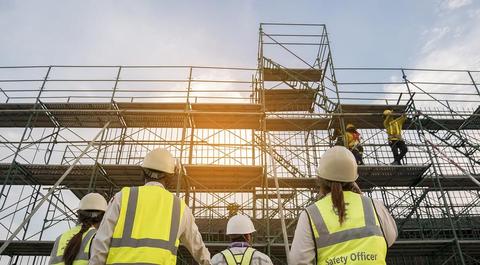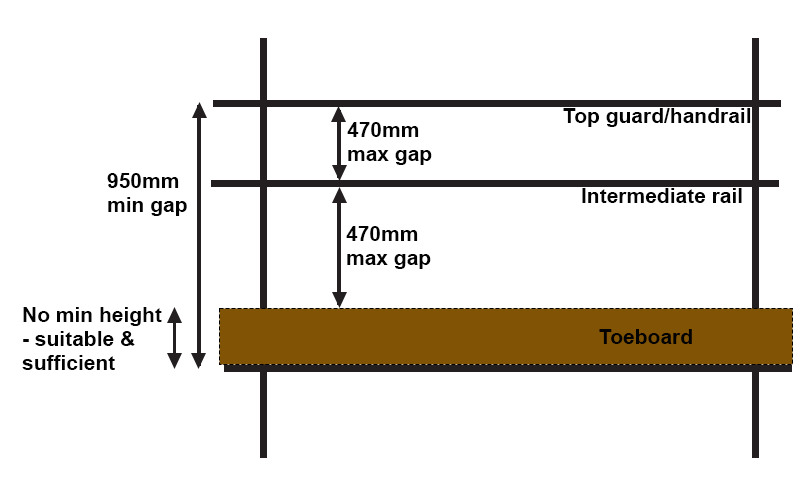Scaffold Guard Rail Guidance

Working at height on a scaffold requires edge protection to prevent falls. Any scaffolding safety inspection should include checking that the guardrails are correct and in position. But what is the regulatory guidance on the correct heights and spacings?
Supporting Legislation
The main guidance on edge protection is covered in The Work at Height Regulations 2005. There is the primary duty to minimise risk:
Where work is carried out at height, every employer shall take suitable and sufficient measures to prevent, so far as is reasonably practicable, any person falling a distance liable to cause personal injury.
However the regulations also go into some detailed prescriptive guidance in Schedule 2, focusing on what height any handrails/guardrails should be for construction work.
1. In relation to work at height involved in construction work—
a. the top guard-rail or other similar means of protection shall be at least 950 millimetres or, in the case of such means of protection already fixed at the coming into force of these Regulations, at least 910 millimetres above the edge from which any person is liable to fall;
b. toe-boards shall be suitable and sufficient to prevent the fall of any person, or any material or object, from any place of work; and
c. any intermediate guard-rail or similar means of protection shall be positioned so that any gap between it and other means of protection does not exceed 470 millimetres.
The Work at Height Regulations 2005 Schedule 2
In addition to the actual dimensions, another key point is that the edge protection provided must be fit for purpose ie:
1. Any structure or part of a structure which supports means of protection or to which means of protection are attached shall be of sufficient strength and suitable for the purpose of such support or attachment.
The Work at Height Regulations 2005 Schedule 2
This effectively means that as well as ensuring any rails are strong and secure, so does the structure they are attached to.

Looking at the dimensions
Top guardrail (handrail) height - at least 950mm
The WAH guidance specifies the top guardrail (often referred to as the handrail) to be at least 950mm high. There’s a minor exception in that handrails already in place before 2005 could be at least 910mm high but this is obviously an increasingly unlikely scenario.
If you handrails aren’t meeting the 950mm rule you are risking falls from height and breaking the law. In the construction industry, falls of this nature can easily be fatal and certainly traumatic, attracting HSE scrutiny and hefty financial penalties.
The regulations require the top guardrail to be at least 950mm but you can choose to go much higher, for example person height. However in this case you would need intermediate rails to stop falls through the gap below the top guardrail/handrail.
Intermediate rail height - at least 470mm
Intermediate rails are required to fill in the gaps. A person could potentially fall through a 950mm gap, especially if they are crouched down to carry out work or to pick up a tool. Intermediate rails are required at least every 470mm, that doesn't mean they has to be installed at exactly 470mm but no vertical gap in your edge protection should be larger than 470mm. Bear in mind that if you’ve installed your top guard rail higher than 950mm, you may need multiple intermediate rails to make sure no gaps are exceeding the 470mm limit.
Toeboard height - suitable and sufficient
Toeboards the are solid barriers installed at a right angle with no gap the bottom of your edge protection. There purpose is to stop things from falling or rolling off the platform. Unlike the top and intermediate rail guidance, there’s no prescriptive minimum heights for toeboards. Instead, toeboards must be suitable and sufficient to prevent falls or people and objects.
Standard toeboards are usually around 150mm in thickness which would be suitable and sufficient in most circumstances. However, you would need to take into account what objects are being used on the scaffolding – are they unstable and especially likely to fall. An additional concern would be whether there are many people present below the scaffolding, especially members of the public who won’t be wearing safety hats.
At SG World we believe that proactive safety measures are the best way to prevent accidents and ensure the well-being of your workforce. Request a free scaffolding safety inspection checklist sample today and discover how SG World can help you build a safer construction site.
If you have any questions or require assistance, please don't hesitate to contact us via email here, or call the team on 01270 588 211
About Lisa Robinson
Lisa - word smith to the gods.
